Dentists Journal
Top Ten Stories of the Week
12/21/2024
All Dentists Journal · Previous Week · This Week · All Time List · Headlines
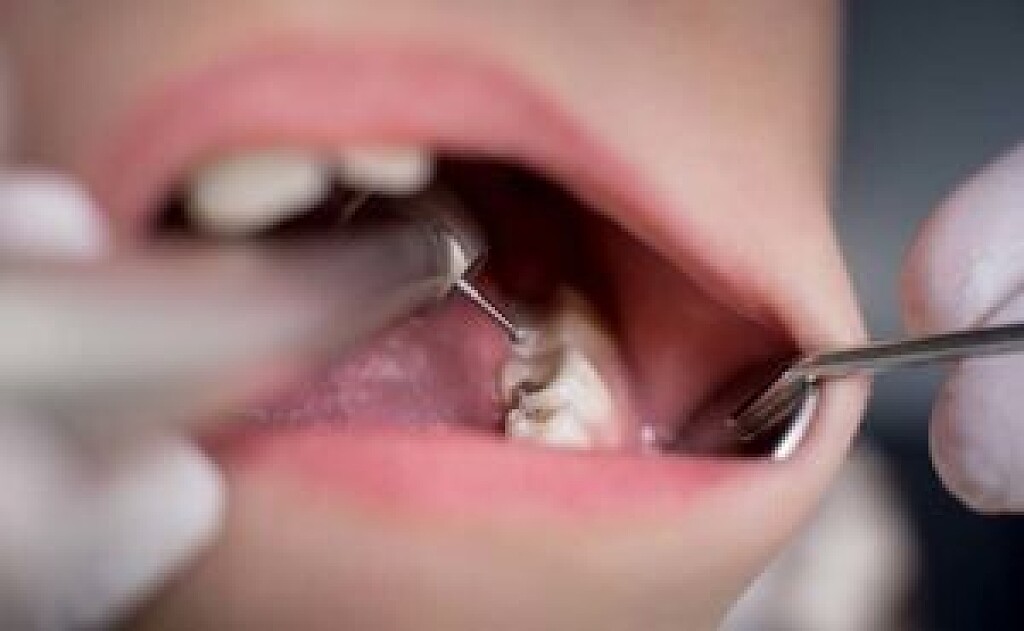
Do I Have a Cavity?: Six Warning Signs of Tooth Decay
Do you think you have a cavity? According to the CDC, over 90% of adults in the USA have had a cavity at some point in their lives.
Cavities are caused by plaque build-up on your teeth. Things that increase the likelihood of cavities are excess sugar, smoking, drinking alcohol, dry mouth, and improper brushing or flossing.
Most cavities can be easily treated. However, there are serious risks of tooth decay in untreated cases, including things like abscesses in the mouth or even gum disease.
Keep reading this guide to learn about the 6 warning signs of tooth decay.

1) Toothache
Toothaches are typically the biggest red flag when it comes to cavities. The pain caused by a toothache may consist of pressure when you eat or it may consist of sudden and painful ache.
Short answer? If you have a toothache make sure you seek treatment to find out the cause.
2) Tooth Sensitivity
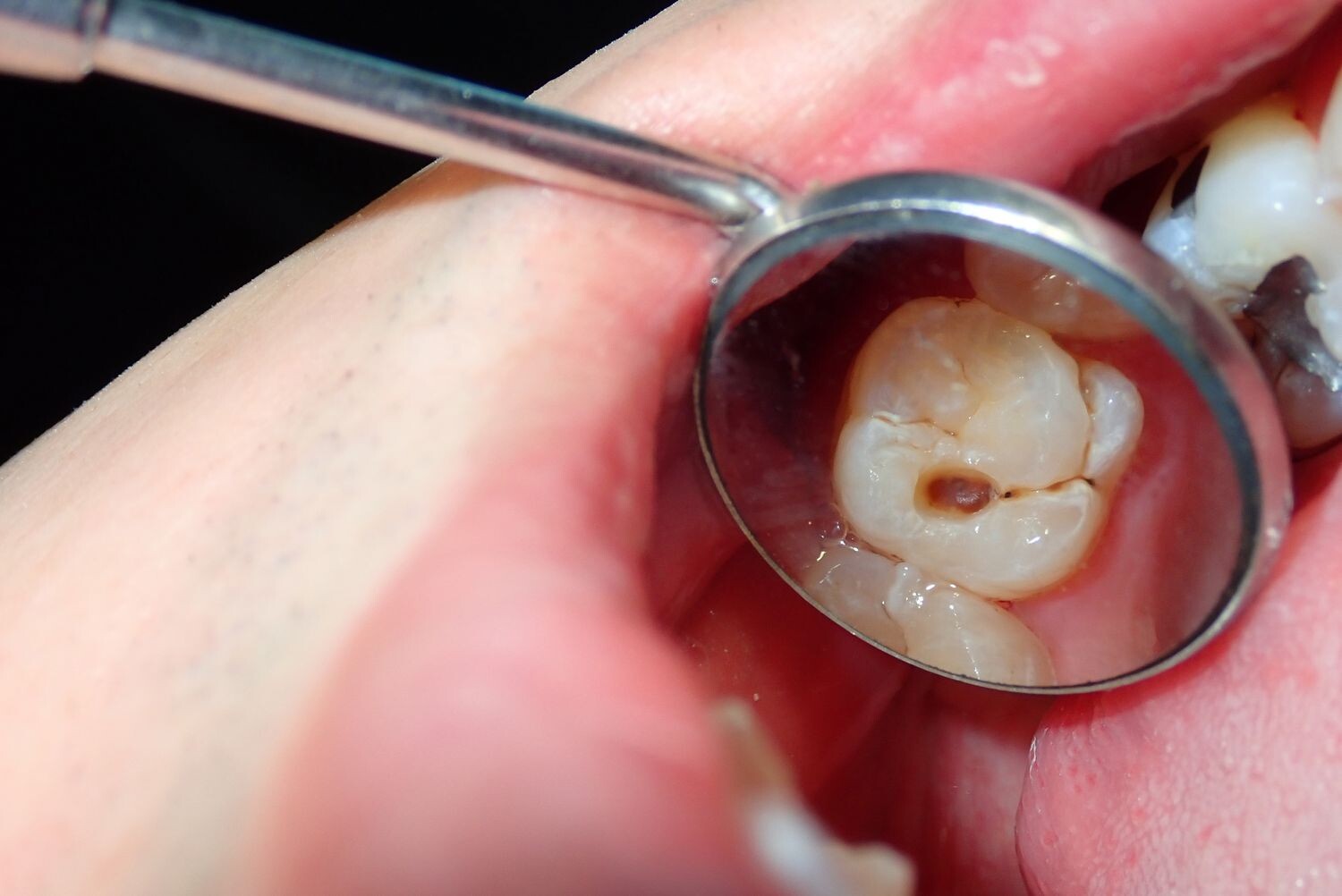
Tooth sensitivity is also one of the most common signs of a cavity. Dental sensitivity typically occurs when consuming hot or cold foods and beverages.
Likewise, sweet and sugary food and drinks may also cause pain or aches in your teeth.
If you notice that your teeth have become sensitive to temperature or sweets, you may very well have a cavity or other dental issue.
3) Teeth Staining
Notice any teeth staining? Unfortunately, stains on the teeth may also signify a cavity.
These stains may show up as white spots, but can be gray, brown, or even black as the cavity worsens. You may also notice redness in your mouth from dental inflammation.
4) Hole in Your Tooth
A hole in your tooth will usually occur in the later stages of untreated cavities. Most of the time you will be able to feel any holes in your teeth with your tongue.
You also may be able to visually notice them when brushing or flossing your teeth.
If you notice a hole in your tooth, see your dentist ASAP.
5) Bad Breath or Taste in Mouth
Sometimes, tooth decay will cause you to have bad breath or a bad taste in your mouth. Bacteria that are lodged between the infected tooth is usually the culprit.
These symptoms can be unpleasant to yourself and others. While it does not mean that you 100% have a cavity, it’s important to rule out the possibility.
6) Facial Swelling
Facial swelling is a less commonly known symptom of tooth decay but is possible. A tooth abscess caused by a cavity is usually to blame in this case.
So, if you notice one side of your face seems puffy and swollen, it’s important to find out the underlying cause.
Signs of Tooth Decay
Those were the 6 warning signs of tooth decay. If you’re wondering, “Do I have a cavity?” it’s important to be aware of any of these tooth decay symptoms and book a dental appointment as soon as you can.
(12/13/2024)by Dr. Parul Mehta, DDS
More Information: https://www.hi-techsmiles.com/do-i-have-a-cavity-6-warning-signs-of-tooth-decay/
Views: 493

What To Look For When Choosing The Right Dentist For You
“I have an excellent doctor! You should go see her… cos she’s just lovely!”
Phrases like this make me cringe. How is it that so many people measure professional expertise with personality? Imagine picking the best brain surgeon to operate on your wife based on their great sense of humour!
Years ago, my husband went to a doctor. The doctor asked him a few questions and quickly summarised with “so what would you like today?”. So he simply listed his wishes – a new prescription for my cholesterol medicine, a referral to a sleep study because my wife thinks I might have sleep apnoea, and a medical certificate for today please! I listened in horror as my husband reported back later that the doctor promptly wrote all 3 requested documents and completed the consultation very satisfied that he had another happy customer. No, there was no discussion about the fact he was pre-diabetic and had gained significant weight over the past year. He didn’t even check what his last cholesterol results were. Although my husband was quite happy with himself for yet another task ticked off efficiently, I was less than impressed.
Choosing the right family dentist is a lot like choosing the right doctor for your family. Sure, there are times when all you need is a flu shot, medical certificate or a prescription. It’s tempting just to opt to see anyone who can provide that one thing you want at the drop of a hat – someone who can get you in quick and let you get on with your life as quickly as possible.

The dental professional equivalent of this is having a go-to dentist who only patches up the odd broken tooth or lost filling. Someone to serve the purpose – clean your teeth, or extract the badly infected tooth and send you away with no expectation to meet again until the next bad thing happens.
I firmly believe that the dentist-patient should begin with a good rapport, but that is only part of the whole package. To help you find the right dentist for you and your family, below are a few aspects to consider.
1. Someone who is in tune with preventing future problems is there with you in the long haul.
A dentist who is committed to long-term patient care is not that hard to pick. They will first listen to your initial concerns and offer solutions to fix the problem. However, she will also offer you valuable insight into why this happened, what other issues could be linked to your initial complaints. Most importantly, she will let you know where you are headed in terms of your future condition.

Let’s use an example: You tell the dentist that you broke a tooth. She can quickly offer to patch this up with a filling or secure it with a crown. Seems quick and simple.
But what if this dentist also took the time to ask you if you have a tendency to grind or clench? Perhaps she touches your neck and facial muscles to see if they have been overworked from the clenching? Do you wake up with headaches or neck pains often? Have you had many teeth or a filling break in a similar way? Next comes the discussion of today’s repair (of course, that’s what you wanted right?) along with the possibility that there could be an underlying cause that could mean anticipating and planning for similar issues with broken teeth in the near future.
The truly amazing doctors are inquisitive and perceptive – that is, they make observations and check the little things that you never realised were relevant to the big picture.
2. Someone who gives you all options but supports your decisions 100%.
As a child, I observed my parents accepting exactly what their doctors and dentists told them they must do. It was the doctors who made decisions about the patient’s treatment. So much so that even now, there is still a whole generation of patients who turn up 6 monthly and literally say, “Don’t tell me anything. Just do whatever you want, I’m in your hands”.
Things are different now thanks to the principle of “informed consent”. As the patient, you have to take responsibility for your own health, so it only makes sense if you also take on the responsibility of choosing the strategies to manage your health issues. But you can only do that if you have the information to help you make the choice that is right for you.
A clinician worthy of your trust is someone who helps you to understand the problems you are facing and gives you strategies to solve them in a way that you can live with.
For example, you may be missing some teeth and wish to get these replaced. The dentist tells you that you can choose a denture, a bridge or an implant and gives you the associated costs. You’d love to have an implant but it is too expensive for right now. Here’s where you could be going home feeling awful that you can’t afford the best and will have to live with a gap for years to come. If you find a dentist who reassures you, “That’s alright. If a denture is a thing you can budget for right now, I will help you get the best denture possible. And we will support you as best we can, keeping the other teeth healthy.” If you feel pressured that you will only be cared for if you choose the most complex solution, then keep looking. You deserve to find someone who not only gives you the information you need but wholeheartedly supports you to make the decisions that are right for you – even if it’s not the most expensive option on offer.
3. Someone who is at the forefront of the latest research and techniques.
Research and development of technology have evolved so rapidly in the last few decades. It’s a really exciting time to be alive!
A dentist should be equally excited to be practising their craft in this age. Even if you have had minimal issues with your oral condition in the past and you always get a good report after your clean and dental check-up, don’t be afraid to ask your dentist, “What’s new?”.
Someone actively keeping up with the latest findings and technology can hardly contain their joy at the possibility of new ways to help their patients achieve a stronger and healthier future. Now not all these developments are necessarily new things you personally will need, but it’s good to know that your dentist is equipped with the latest information. It’s also handy to keep in mind that a good clinician also has enough humility and confidence to acknowledge when there is a need to call on colleagues with a different set of special skills or fields of interest to best help their patients.
The relationship between doctor and patient is very personal and based on trust. I hope everyone can find a dentist who truly cares about and supports their long-term health. When you do, ask them if they would also care for your family and friends too.
(12/14/2024)by Myers Street Dental Clinic
More Information: N
Views: 490

Can An Infected Tooth Cause Cold And Flu-Like Symptoms?
Did you know that a bad tooth can cause more than just dental pain? It turns out that an infected or decaying tooth may actually be linked to cold and flu-like symptoms. While it may seem strange, the connection between oral health and overall well-being is becoming more apparent.
In this article, we will explore how a bad tooth can potentially contribute to cold and flu symptoms and what you can do to prevent this from happening. So, buckle up and get ready to dive into the fascinating world of dental health and its impact on our immune system.
Connection between Bad Teeth and Cold and Flu Symptoms
Yes, you read that right – a bad tooth can actually cause cold and flu-like symptoms. Let's explore the connection between bad teeth and cold and flu symptoms in more detail.
First and foremost, it's important to understand what we mean by a "bad tooth." A bad tooth refers to a tooth that is significantly decayed, infected, or damaged. This can occur due to poor oral hygiene, a high sugar diet, trauma to the tooth, or other dental issues.

So how exactly can a bad tooth cause cold and flu-like symptoms? The key lies in the proximity of the tooth to various structures in your mouth and head. When a tooth becomes infected or decayed, it can lead to the formation of an abscess – a pocket of pus caused by a bacterial infection.
This abscess can result in the spread of bacteria throughout the body, leading to systemic symptoms similar to those experienced during a cold or flu. Here are some common cold and flu-like symptoms that can be caused by a bad tooth:
Fever: An abscessed tooth can cause your body temperature to rise, resulting in a fever. If you're experiencing a fever along with other flu-like symptoms, it's worth considering a dental check-up.
Fatigue: Dental infections can put a strain on your immune system, causing you to feel tired and run down. If you're feeling unusually fatigued, it could be due to a dental issue.
Sinus congestion: The roots of your upper teeth are located close to your sinuses. If a tooth infection spreads to the sinuses, it can cause congestion, stuffiness, and a feeling of pressure in your face.

Facial pain: Infected or decayed teeth can cause facial pain, which can often be mistaken for sinus pain. If you're experiencing facial pain along with other cold or flu-like symptoms, it's important to rule out dental issues.
Swollen lymph nodes: Infections in the mouth can cause the lymph nodes in your neck and jaw to become swollen and tender. If you notice swollen or painful lymph nodes, it may be a sign of a dental problem.
If you're experiencing any of these symptoms, it's crucial to seek dental care as soon as possible. Your dentist will be able to assess the condition of your teeth and determine if a bad tooth is the cause of your cold and flu-like symptoms.
Luckily, treating a bad tooth can not only alleviate your symptoms but also prevent further complications. Depending on the severity of the dental issue, treatment options may include root canal therapy, extraction of the tooth, or other necessary procedures.
In addition to seeking professional dental care, practicing good oral hygiene is essential for preventing tooth decay and infections. This includes brushing your teeth twice a day, flossing daily, and visiting your dentist regularly for check-ups and cleanings.
In conclusion, a bad tooth can indeed cause cold and flu-like symptoms. Understanding the connection between dental issues and systemic symptoms can help you identify the underlying cause of your illness and seek appropriate dental treatment. So, if you've been experiencing cold and flu symptoms, don't forget to consider the health of your teeth!
Oral Infections and the Impact on Respiratory Health
Did you know that an infected tooth can potentially cause cold and flu-like symptoms? It may come as a surprise, but our oral health is intricately linked to our overall well-being, including our respiratory health. Let's explore how oral infections can affect our respiratory system and what we can do to prevent and treat these infections.
When a tooth becomes infected, it means that bacteria have invaded the tooth's pulp, causing inflammation and pain. However, the effects of an infected tooth don't stop at the mouth. The bacteria can spread to other parts of the body, including the sinuses, throat, and even the lungs, leading to respiratory issues.
One of the ways an infected tooth can impact respiratory health is by causing sinusitis. The sinuses are hollow spaces in the skull, and they are connected to the nasal passages. When the bacteria from an infected tooth reaches the sinuses, it can lead to an infection, resulting in symptoms such as nasal congestion, facial pain, and a runny nose – similar to what you might experience with a common cold or flu.
Furthermore, an infected tooth can also contribute to the development of bronchitis and pneumonia. As the bacteria travel down the respiratory tract, they can reach the lungs and cause infections. This can lead to symptoms such as cough, chest pain, difficulty breathing, and even fever – all common signs of respiratory illnesses.
So, what can you do to prevent and treat oral infections to protect your respiratory health? Here are some tips:
Practice good oral hygiene: Brush your teeth twice a day with a fluoride toothpaste, floss regularly, and use an antiseptic mouthwash to help kill bacteria in your mouth.
Visit your dentist regularly: Regular dental check-ups and cleanings can help identify and treat any potential oral infections before they become more serious.
Treat dental issues promptly: If you have a decaying or damaged tooth, seek immediate dental treatment to prevent the infection from spreading.
Maintain a healthy lifestyle: Eating a balanced diet, getting enough sleep, and managing stress can help boost your immune system and keep you healthy overall, reducing the risk of infections.
If you suspect that an infected tooth is causing cold and flu-like symptoms, it's crucial to seek dental and medical attention. Your dentist can assess the tooth and recommend the appropriate treatment, which may involve a root canal or tooth extraction. Additionally, your doctor can evaluate your respiratory health and provide any necessary medication to treat any associated infections.
In conclusion, oral infections can indeed have an impact on respiratory health. It's essential to prioritize oral hygiene, visit your dentist regularly, and promptly address any dental issues to prevent the spread of bacteria and maintain good overall health. By taking care of your mouth, you can take significant steps towards safeguarding your respiratory system and enjoying a healthier, infection-free life.
Dental Health and the Immune System: A Link to Cold and Flu
When it comes to maintaining your overall health and well-being, often people forget about the important role oral health plays in the equation. Your mouth serves as the gateway to your body, and maintaining good dental health is crucial for a strong immune system.
One common dental issue that can have an impact on your immune system is a bad tooth. A bad tooth refers to a tooth that is decayed, infected, or damaged. If left untreated, a bad tooth can lead to a host of problems, including cold and flu-like symptoms.
Here are a few reasons why a bad tooth can cause symptoms similar to a cold or flu:
Infection: When a tooth becomes decayed or damaged, it creates an opening for bacteria to enter the tooth and cause an infection. This infection can spread to the surrounding tissues, leading to swelling, pain, and inflammation. These symptoms are similar to what you might experience during a cold or flu.
Sinus Involvement: Some bad teeth, particularly those in the upper jaw, can be closely related to the sinuses. When a tooth infection spreads to the sinuses, it can cause sinusitis, which presents symptoms similar to the common cold or flu. These symptoms may include congestion, facial pressure, headache, and a runny nose.
Weakened Immune System: Chronic infections, such as a long-standing bad tooth, can put strain on your immune system. Your immune system is responsible for defending your body against harmful bacteria and viruses. When it is constantly fighting an infection, it may become weakened, leaving you more susceptible to cold and flu viruses.
Spread of Bacteria: Bacteria from an infected tooth can enter the bloodstream and spread throughout the body. This can lead to systemic inflammation and further compromise your immune system. As a result, you may experience cold and flu-like symptoms, such as fatigue, body aches, and a general feeling of malaise.
Now that you understand the link between dental health and your immune system, it's important to take action to prevent and treat bad teeth.
(12/13/2024)by MedShun
More Information: https://medshun.com/article/can-a-bad-tooth-cause-cold-and-flu-symptoms
Views: 572
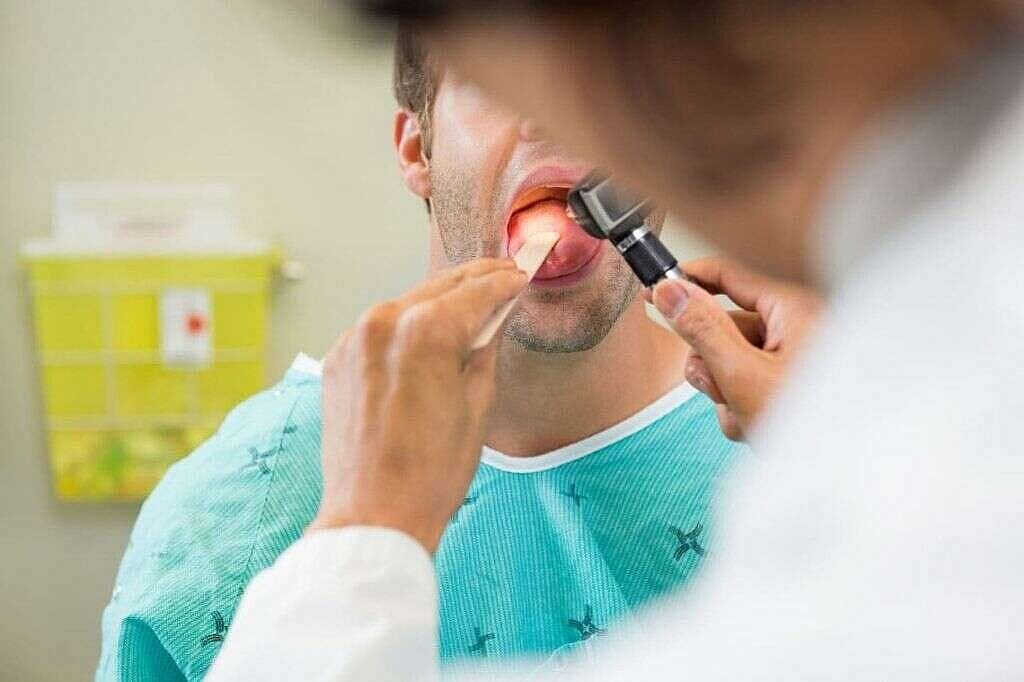
Fissured Tongue: Causes and Treatment
Fissured tongue causes a change in appearance of the tongue. Discover the causes of the disorder and what you can do if you have it.
A fissured tongue is a benign abnormality that occurs on the tongue surface. Although it may appear unsightly at first glance, it doesn’t really affect people’s lives.
The normal tongue is flat along most of its length. A fissured tongue has a deep groove in the middle and may also have small fissures on the surface. This gives it a wrinkled appearance.
This condition isn’t serious in itself, is usually painless, and isn’t contagious. According to the American Academy of Oral Medicine, fissured tongue occurs in 5% of the U.S. population. It tends to occur more frequently in young males.
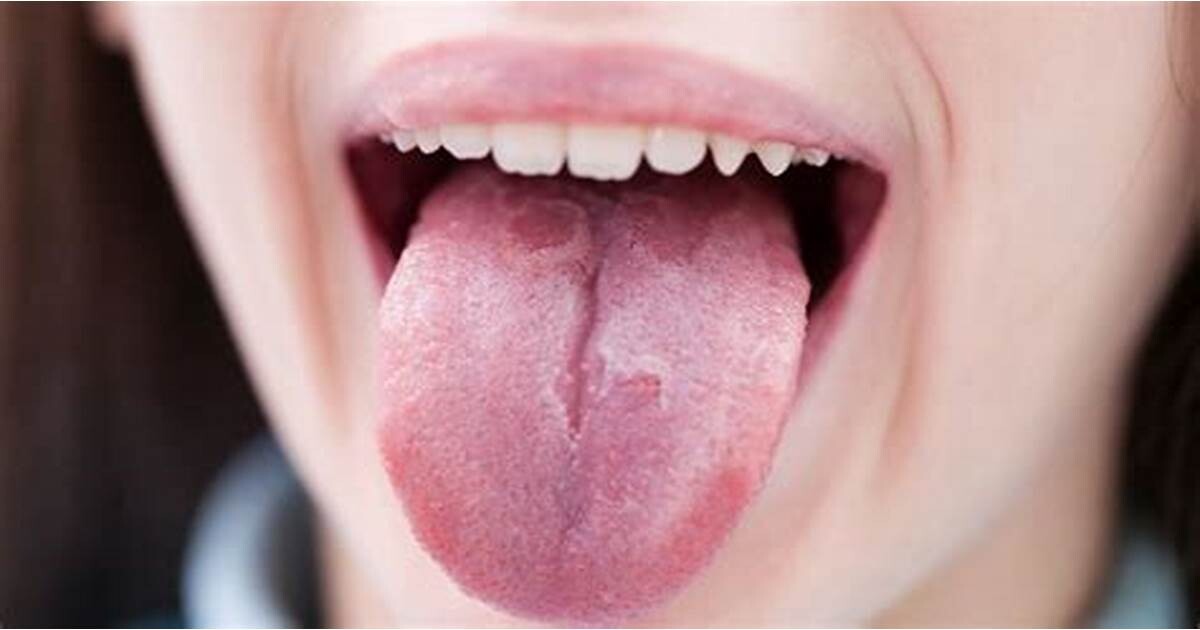
As we’ll tell you today, its origin is usually associated with hereditary causes and the symptoms become more evident as a person ages. However, in some cases, it can be associated with certain diseases, so it’s advisable to seek an accurate diagnosis.
In this article, we’ll tell you the characteristics of fissured tongue, its causes, and how it’s treated. Read on and learn all about this oral condition.
What is fissured tongue?
Fissured tongue is a benign condition that affects the normal anatomy of the lingual organ. It’s also called scrotal tongue, because of its similarity to the appearance of the scrotum.
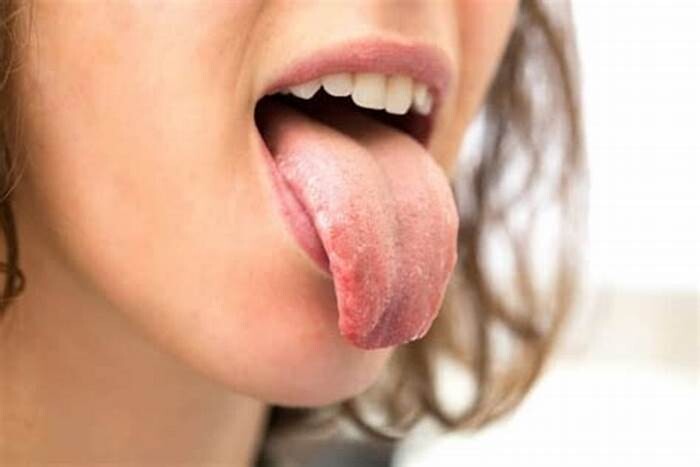
As the name implies, the surface of the tongue has multiple fissures or cracks. These may appear on the dorsum of the tongue or extend to the sides.
In general, there’s usually a median fissure in the center of the tongue and several cracks on the rest of the surface. The size and depth of these cracks vary from case to case, but usually range from 2 to 6 millimeters (up to 0.23 inches). The grooves may be connected to each other, making the tongue appear to be composed of separate lobes.
This condition usually doesn’t cause pain or discomfort. However, some people who have it often have tongue swelling, bad breath, and increased sensitivity to certain substances and flavors.
Signs of fissured tongue can occur as early as childhood; however, they become more evident and noticeable as the person ages.
Men are slightly more likely to suffer from fissured tongue than women. Older adults who, in turn, have dry mouths tend to have more obvious symptoms.
It’s important not to confuse this anomaly with migratory glossitis, or geographic tongue. This disorder is characterized by depapillated areas on the tongue surface. These are seen as rounded red spots with whitish edges, which change place over time. Although it’s important to differentiate between these disorders, there are cases of people with both abnormalities on their tongue.
Symptoms of fissured tongue
The main characteristic of fissured tongue is the wrinkled appearance of the lingual organ. A crack in the center of the tongue and several irregular grooves on the rest of its surface alter the flat appearance.
Cracks are usually asymptomatic, that is, they don’t cause pain or discomfort to the patient. However, there are occasions in which some of the following occur:
Pain
Bad breath or halitosis
Swelling or inflammation of the tongue
Discomfort or burning to certain stimuli and substances
If there is no proper oral hygiene, candidiasis may develop.
Complications
Beyond the possibility that some of the symptoms we have told you about may appear, patients with a fissured tongue may experience discomfort. The most common complication is the development of an infection caused by the fungus Candida albicans (oral candidiasis).
This infection can arise as a result of various situations, however, the most common is inadequate oral hygiene. The accumulation of bacteria inside the tongue fissures affects the balance of the normal flora of the mouth and favors the proliferation of fungi.
Candidiasis on the tongue causes white or red lesions, pain, burning, and inflammation. If not treated in a timely manner, it affects the normal functions of the mouth, such as eating, swallowing, and speaking.
To prevent the occurrence and aggravation of this fungal infection, it’s essential for patients with cracks on their tongues to maintain thorough oral hygiene. Special attention to cleaning the tongue is key.
This removes food debris and bacteria that accumulate in the fissures, and prevents infection. In addition, removing tongue debris also prevents the development of bad breath.
Common causes of fissured tongue
A precise cause of cracked or fissured tongue hasn’t yet been identified. On the one hand, it could be due to genetic or hereditary factors, or it could be associated with a different underlying condition.
Fissured tongue can be congenital and appear from birth or develop throughout a person’s life. As we have already told you, the symptoms tend to increase with age.
The hereditary and genetic factors are among the most relevant in explaining the onset of the disorder. Often, several members of the same family have these particular languages.
In addition, this condition is often a symptom of other conditions, such as Down syndrome or Melkersson-Rosenthal syndrome. In sone cases, the occurrence of this condition is associated with other health conditions:
Psoriasis
Diabetes mellitus
Vitamin B deficiency
Bruxism, stress and anxiety
Allergic reactions to some foods or medications
Using alcohol and tobacco: these substances cause dry mouth, which favors the appearance of cracks in the tongue.
Treatments for fissured tongue
Fissured tongue doesn’t require any specific treatment to reverse it. However, certain hygiene practices will be necessary to help keep this organ healthy and functional and prevent associated complications.
To do so, it’s important to visit the dentist frequently. In order to obtain an accurate diagnosis, it’s necessary to rule out other lesions and understand how to take care of fissured tongue.
Regular dental check-ups every six months allow the dentist to evaluate the state of the tongue and rule out the presence of other pathologies. If mycosis or other infections develop, the dentist can initiate the appropriate treatment.
It’s also a good idea to visit the dentist if the tongue starts to burn, itch, or hurt. These symptoms may be indicative of a complication.
On the other hand, in addition to check ups, there are some simple practices that can prevent complications associated with a fissured tongue. We’ll tell you about them.
Strict oral hygiene
Keeping the oral cavity clean is one of the best strategies to prevent fissured tongue complications. Food debris and bacteria can accumulate in the crevices of the tongue, causing bad breath, and promoting infections.
It’s important to brush with fluoride toothpaste and floss to remove plaque from the mouth. In addition, special attention should be paid to cleaning the tongue.
To do so, it’s best to use a tongue scraper, or tongue cleaner. This is an instrument that’s specially designed to thoroughly clean the irregular surface of the tongue.
Cleaning consists of moving the instrument back and forth several times over the entire tongue surface. This allows you to get rid of debris and bacteria trapped in its grooves or cracks.
Not having a tongue scraper is no reason not to keep your tongue healthy. Keeping a toothbrush for this purpose, or using the back of the toothbrush head are two options.
Tongue hygiene should be carried out at least once a day. However, in patients with fissured tongue, increasing the frequency may be of greater benefit.
Supplementing cleaning with oral rinses is a way to remove debris that can’t be reached with a scraper. At the same time, you will obtain fresh, clean breath.
Reduce the consumption of irritating foods
A burning or itching sensation on the tongue on contact with certain substances is another complication that can appear in people with tongue fissures or cracks. Avoiding highly acidic, salty, bitter, and spicy foods is one strategy to prevent irritation.
Proper and frequent tongue brushing, proper nutrition, and the absence of harmful habits help prevent infection and discomfort. Twice-yearly visits to the dentist complete the care routine, in order to ensure that fissured tongue doesn’t become a problem for the sufferer.
(12/14/2024)by Step To Health
More Information: N
Views: 553

Foods That Prevent Tooth Decay And Cavities Naturally
How to Prevent Cavities and Tooth Decay
It's no fun passing up sugary treats like cookies and candies. But when it comes to tooth decay, food choices play an important role. Some foods can harm your teeth, while others contain essential nutrients to keep them healthy and strong. To help prevent tooth decay, keep the following food choices in mind.
Calcium
Calcium is a prime ingredient for preventing tooth decay, especially for growing children. Dairy is a great source, with choices such as milk, yogurt and cheese. And calcium isn't hiding in the fat, so skim milk and low-fat yogurt are just as good. Other options are leafy greens such as broccoli and bok choy, canned fish with bones, almonds, Brazil nuts and dried beans.

Fruit, Fiber and Veggies
Eating high-fiber foods keeps saliva flowing, which helps create mineral defenses against tooth decay. Good sources of fiber are dried fruits such as dates, raisins and figs, and fresh fruits, like bananas, apples and oranges. Other options include veggies, such as beans, Brussels sprouts and peas, along with peanuts, almonds and bran.
Whole Grains
Whole grains provide B vitamins and iron, which help keep gums healthy. Whole grains also have magnesium-an important ingredient for bones and teeth. In addition, whole grains are high in fiber. Look for foods such as bran, brown rice, and whole-grain cereals and pasta to be good sources of whole grains.

Avoid Foods that Cause Cavities
When looking to follow a healthy diet that's good for your teeth and the rest of your body, try sticking to the food pyramid. The pyramid is structured to give you a healthy serving of all the necessary food groups you need throughout the day.
Sugar Snacks
When you get the munchies, focus on choosing healthy foods, like the ones we mentioned earlier. Try to steer clear of sweets, because sugar partners with plaque to weaken enamel, leaving you vulnerable to tooth decay. In fact, each time you eat a sugary snack, your teeth are under siege for the next 20 minutes. Brushing with an Oral-B electric toothbrush after eating sugary snacks can help prevent plaque buildup and the onset of tooth decay.
(12/16/2024)
by Oral B
More Information: https://www.oralb.co.uk/en-gb/oral-health/conditions/cavities-tooth-decay/foods-that-prevent-tooth-decay-cavities-naturally
Views: 500

Glossitis: What to Know About Inflammation of the Tongue
The tongue is a small, muscular organ in the mouth that helps with tasting and swallowing food, as well as articulating speech. On occasion, however, the tongue may develop glossitis, a condition that causes it to swell, become red in color, and develop a smooth appearance on its surface.
There are a variety of different things that can cause glossitis and different types that a person can develop—both of which we’ll be discussing today, along with symptoms to look out for and how it is diagnosed and treated. Read on to find out more about glossitis with these 12 facts.
1. Type: Acute Glossitis
There are several different types of glossitis, one of which is referred to as acute glossitis. According to Healthline, this type causes “inflammation of the tongue that appears suddenly and often has severe symptoms.”
In addition to swelling, other severe symptoms include pain and shortness of breath (known medically as dyspnea). Acute glossitis most commonly occurs due to an allergic reaction or from trauma to the tongue, such as burns or bites.
2. Type: Chronic Glossitis

With chronic glossitis, inflammation of the tongue occurs on a long-term basis, and “may begin as a symptom of another health condition,” says AARP.org. Interestingly, chronic glossitis is more common than acute glossitis.
One subtype of chronic glossitis is known as chronic superficial glossitis, because it’s not the tongue itself that becomes inflamed but rather the mucous membrane that covers it. This particular type is especially common among alcoholics, tobacco users, and those who have chronic stomach or intestinal diseases.
3. Type: Atrophic Glossitis
According to Prime Health Channel, atrophic glossitis (also known as Hunter glossitis) “derives its name from the fact that the tongue gets washed away of its original color to assume a beefy red color and is automatically smoothened.”
And by smoothened, the source means that the tongue loses many of its papillae, which are the small bumps that normally cover the surface of the tongue. This can give the tongue a “glossy appearance,” says Healthline.
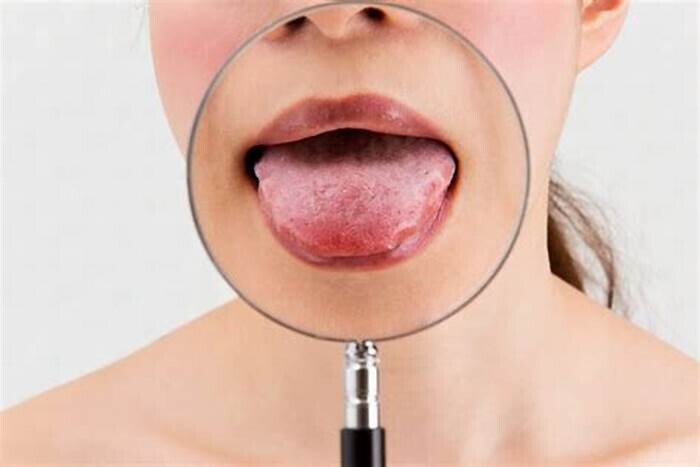
4. Type: Idiopathic Glossitis
Idiopathic glossitis “…is characterized by the inflammation of the mucous membrane and the overall muscle of the tongue,” says Prime Health Channel. Unfortunately, however, the cause of this particular type of glossitis is unknown.
As with atrophic glossitis, those with idiopathic glossitis will develop a smoothened tongue, often losing “up to 50-percent or more of the papillae,” says AARP.org, giving it the same glossy appearance.
5. Cause: Allergic Reactions
One of the most common causes of glossitis—particularly acute glossitis—is an allergic reaction. These allergic reactions may be to “medications, food, and other potential irritants that may aggravate the papillae and the muscle tissues of the tongue,” says Healthline.
Certain medications used to treat high blood pressure—known as angiotensin converting enzyme (ACE) inhibitors—are particularly common irritants, as are “mouthwash, breath fresheners, toothpastes, plastic in dentures, [and] dyes in candy…” indicates Prime Health Network.
6. Cause: Disease and Infections
Glossitis may also occur as a result of contracting a disease, particularly those that affect the body’s immune system, as they may “attack the tongue’s muscles and papillae,” says Healthline. Herpes simplex, “a virus that causes cold sores and blisters around the mouth,” is one such example.
Infections can also cause glossitis, including those caused by bacteria, yeast, or fungi (such as thrush, which produces “white patches on the tongue and inside of the mouth,” says WebMD). Poor oral hygiene and low saliva production (dry mouth) can also lead to infections, which increases a person’s chances of developing glossitis.
7. Cause: Vitamin Deficiencies
Another common cause of glossitis is vitamin deficiency. If you’re not getting enough iron, for instance, low myoglobin levels may result. This can lead to glossitis because “myoglobin is a protein in red blood cells that’s important for muscle health, including the tongue’s muscle tissue,” says Healthline.
Other vitamin deficiencies that can cause glossitis are vitamin B12, vitamin E, riboflavin, folate, and niacin. Regardless of which vitamin is the culprit, this type of glossitis is aptly referred to as glossitis vitamin deficiency.
8. Cause: Mouth Trauma or Injury
As mentioned earlier, trauma or injury in the mouth can lead to glossitis as well. Common examples include biting, cutting, chewing, or burning tissue of the tongue or elsewhere in the mouth. Additionally, inflammation may be caused dental appliances, such as braces or ill-fitting dentures.
And while it may look cool, piercing the tongue also increases the likelihood of developing glossitis, as it makes the muscular organ more susceptible to infections and wounds.
9. Symptoms
Although we’ve already mentioned several of the symptoms of glossitis, they are worth repeating. Pain or tenderness in the tongue is among the most common to be mindful of, as is swelling or inflammation.
In some cases, this swelling may become so severe that it affects a person’s ability to swallow, chew, or speak. If this occurs, it is important to seek medical attention immediately. The tongue may also change color, becoming pale or bright red, and take on a smooth appearance due to loss of papillae.
10. Diagnosis
When it comes to diagnosis, the U.S. National Library of Medicine says that your dentist or doctor will assess your condition by doing an exam to look for “finger-like bumps on the surface of the tongue (called papillae) that may be missing” and a “swollen tongue (or patches of swelling).”
Additionally, the individual conducting the exam may ask questions about your medical history and lifestyle in an effort to determine the cause of glossitis. Samples of blood and saliva may also be taken to help confirm the diagnosis.
11. Treatment: Medications
How glossitis is treated largely depends on what is causing the condition to occur. “If glossitis stems from a bacterial, fungal or yeast infection,” the Colgate-Palmolive Company says, “your medical or dental professional may prescribe a medication to alleviate the symptoms and heal the infection.”
In combination with antibiotics or other medications, topical corticosteroids may also be prescribed and are intended to help reduce symptoms of pain and redness in the tongue or other areas of the mouth.
12. Treatment: Home Care
In other cases of glossitis, home care procedures may be the best course of treatment. If the condition is caused by a virus, for instance, the Colgate-Palmolive Company says “…a doctor can recommend a routine plan to treat the symptoms at home. This plan involves keeping your tongue and whole mouth healthy by brushing twice daily and flossing.”
Or, if the glossitis is caused by a deficiency in certain vitamins, Prime Health Channel indicates it may be best treated by “preparing a diet chart and that is rich in the deficient nutrients.” And in cases where glossitis is due to an allergic reaction or irritant, it is important to identify the cause and eliminate or avoid it to prevent future reactions.
(12/16/2024)by Active Beat
More Information: https://activebeat.com/your-health/glossitis-12-things-to-know-about-inflammation-of-the-tongue/
Views: 667
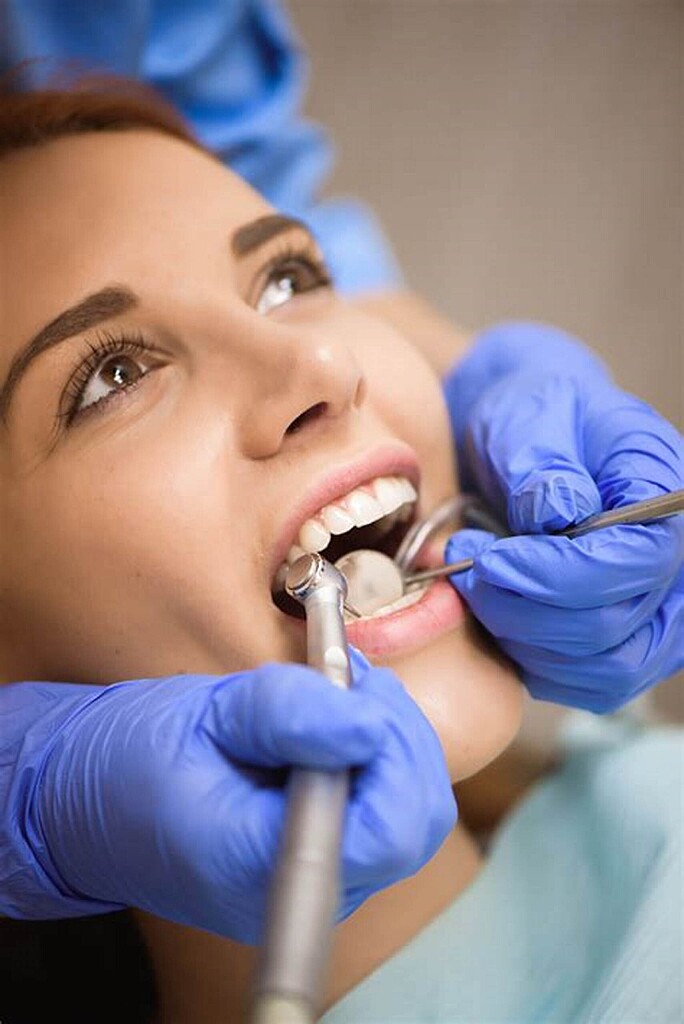
A Few Facts to Know About Gum Disease Treatment
What is Gum Disease?
Gum disease, also known as periodontal disease, is an infection that damages soft tissue in the mouth and the bone which supports a patient’s teeth. Oral bleeding is normal after certain procedures and if your toothbrush is too hard on your gums; but if you notice chronic bleeding when brushing or if there’s any unexplained bleeding, it could signify gum disease. Thankfully, Wetaskiwin dentists can treat your gums and prevent the disease from spreading.
Gingivitis is the first stage of this condition, and it is characterized by inflammation. This phase of infection is very common and usually goes unnoticed. If you experience tender or swollen gums or bleeding after brushing, it could be an indication that you’ve developed gingivitis. With a good oral hygiene routine, symptoms can go away.
The advanced stage of gum disease is known as periodontitis. This will cause a patient’s gum to detach from their teeth, creating a space or a“pocket” that harbours bacteria and infection, which affects the surrounding teeth, tissues, and ligaments. If left untreated, periodontitis can eventually lead to tooth decay. The infection can also spread to the bloodstream and affect a patient’s general health. Having a dental clinic that offers gum disease treatment in Wetaskiwin is important to ensure your oral health is restored. Wetaskiwin Family Dental is here to help you treat and prevent further infections.
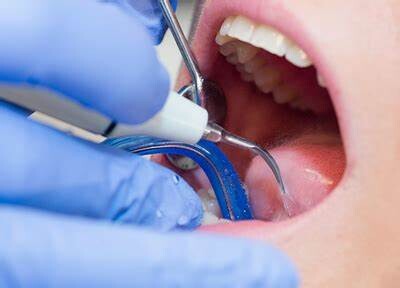
What You Should Know About Gum Disease Treatment
Gum disease can become a dangerous condition if it goes unaddressed. Fortunately, dentists in Wetaskiwin use up-to-date technology and treatments to treat gum disease, including:
1. scaling and planning
This is the first treatment dentists can perform to treat gum disease. Scaling removes the tartar that has accumulated on the tooth and gum line. Your dentist will then reattach your gum to the teeth.
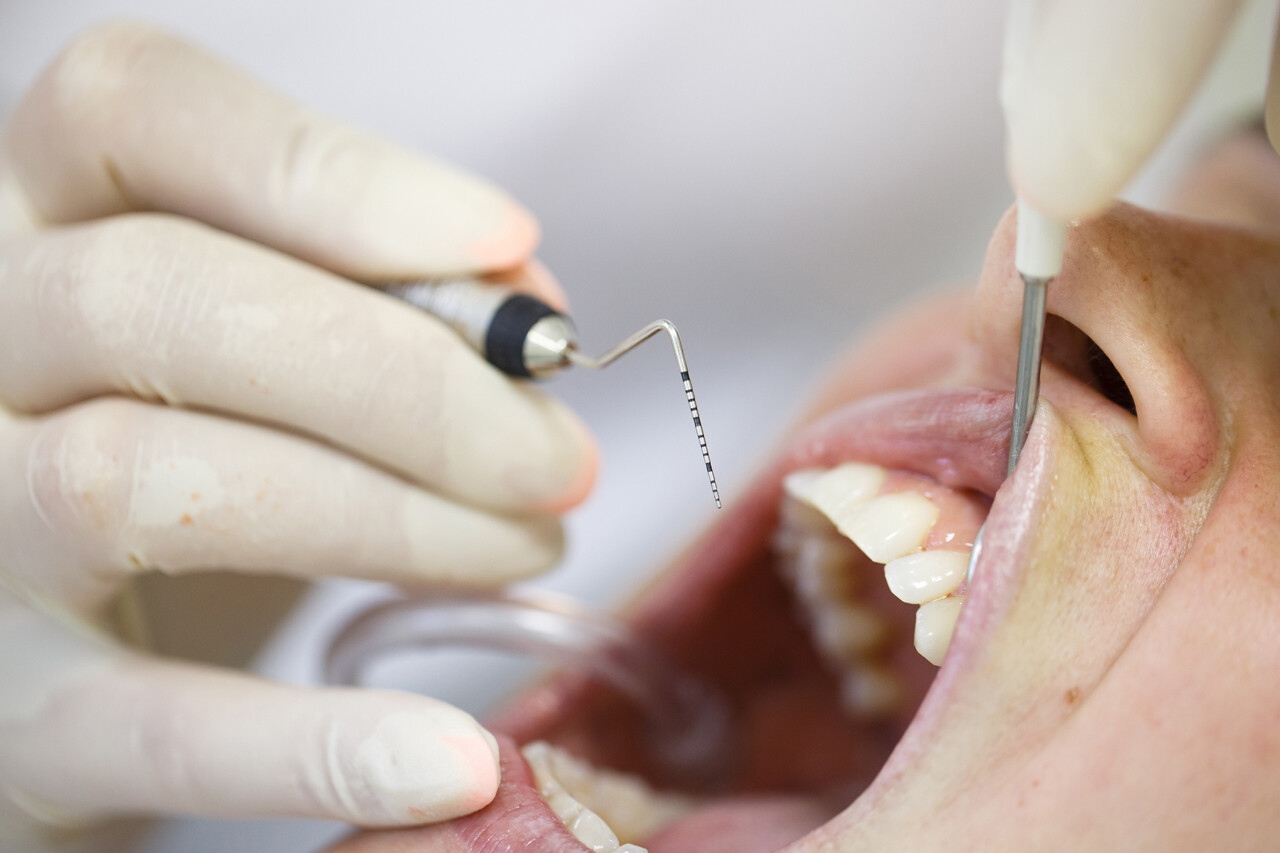
2. Medication
Your dentist may prescribe you antibiotics to help reduce bacteria and help control the infection. The dentist may also recommend other ways to prevent the infection from growing until it can be treated properly with an advanced procedure.
3. Flap surgery
This surgery will eliminate the gum pockets created by the disease. A dentist will make an incision on the gums and reposition them back toward the bone. Once this is done, the bone may need to be contoured (or manipulated) so the gum tissue can attach and heal.
4. Bone graft
If your gum disease has advanced, it can affect your bones. Patients might need a bone graft to rebuild the bone structure affected by the infection.
5. Soft tissue graft
Gum disease can affect your mouth’s soft tissue and cause tissue loss. The dentist will need to get material from the roof of your mouth (also called your palate) and reattach it to the areas that have lost tissue to reinforce and prevent further loss. This will help reduce gum recession.
5. Tooth extraction
When an infection is too developed, the dentist may need to remove the tooth to restore oral health. The tooth can then be replaced with a restoration treatment.
Gum Disease Can Be Prevented
Maintaining a good hygiene routine and visiting a dentist near you for regular check-ups is the best way to prevent gum disease. Make sure you brush your teeth twice daily and floss at least once to prevent plaque accumulation. To remove any additional bacteria, finish your routine with mouthwash. A good hygiene routine at home is not enough, so ensure you schedule cleaning appointments twice a year. During the appointment, a dentist will check for any infection.
If you fear you have gum disease and are looking for gum disease treatment near you, contact Wetaskiwin Family Dental to book an appointment today.
(12/17/2024)
by Wetaskiwin Family Dental
More Information: https://www.wetaskiwinfamilydental.com/a-few-facts-to-know-about-gum-disease-treatment/
Views: 596

What Is Involved in the Process of Deep Cleaning of Teeth?
Did you know that 26% of adults in America have untreated dental decay? Annual deep cleaning of teeth is the key to preventing this type of teeth and gum disease. Unfortunately, many people are scared of going to the dentist. Just the words ‘deep cleaning’ is enough to send some patients off shivering.
Luckily, deep cleaning doesn’t need to be frightening. In this article, we’ll walk you through everything the procedure entails. That way you’ll know exactly what to expect next time you schedule a visit. Let’s get started!
What Is Deep Cleaning of Teeth?
Deep cleaning is different from a regular dental cleaning. This type of procedure goes below the gum line. It does this to clean hard-to-reach spots like the roots and pockets at the base of your tooth. A substance known as tartar can build-up around the exterior and roots of teeth. If left unchecked, then this tartar can cause serious bacterial infections.
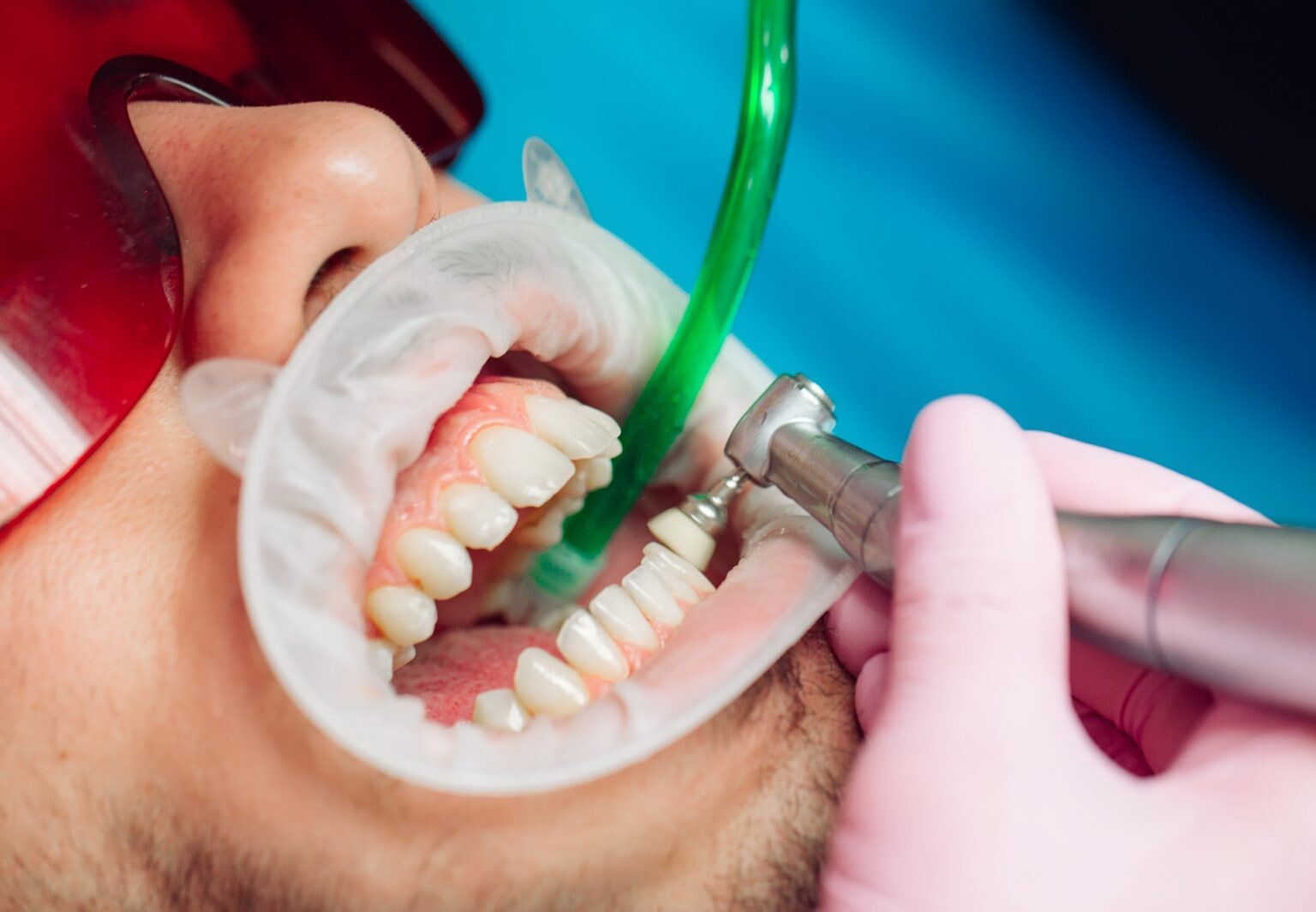
As such, dentists use a technique known as periodontal scaling and root planing to remove this substance. If the tartar can’t be removed using manual scraping, then they’ll also use an ultrasonic removal device. This is the main distinction between deep cleaning and regular cleaning. The process of removing tartar can sometimes be quite demanding.
As such, it can last hours and might need to be broken up into multiple sessions. Ultimately, it depends on how bad the case is and how sensitive your teeth are. While a deep cleaning might sound tedious, it’s a vital part of fighting against dangerous infections. If left untreated it can warp into an even worse condition, like a root canal. So how do you know when a deep cleaning is needed?
When is Deep Cleaning Necessary?
The ADA recommends scheduling dentist appointments for intervals recommended by the dentist. There’s no one set answer for how often you should get a deep cleaning. That’s because every unique case requires a different approach. During these visits, your dentist will recommend whether or not you should get a deep cleaning.

One clear sign of needing deep cleaning is checking for gum disease. You can do this by measuring how far your gums pull away from your teeth. Any pocket that’s more than five millimeters deep will require immediate deep cleaning. Other symptoms of gum disease include things like:
Swelling gums
Bleeding gums
Bruising around the gums
Pus in the gums
Bad smelling breath
Gum disease occurs when bacteria get into pockets and roots of the teeth. Certain types of gum diseases will also require additional treatments. It’s also recommended to get a deep cleaning if it's been more than six months since your appointment with your dental hygienist.
How Does the Procedure Work?
Before the procedure, your dentist will go over your medical history and perform an x-ray. That way, they have a good idea of which areas to focus on. After this preliminary planning stage, the dentist will measure the depths of the gum sockets using a special tool.
This process is also used for probing to determine if the person has gingivitis or periodontitis. After this, the dentist will begin the scaling process. As we mentioned earlier, this is a scraping that removes tartar from the teeth. If needed, an ultrasonic tool is also used. After this, the teeth are polished using a gritty toothpaste.
Then, an air polisher is applied to smooth out the teeth. The dentists may go through final flossing as well. Finally, a fluoride treatment might be used. This process helps remineralize the enamel on your teeth.
Does the Procedure Hurt?
Most of the time, any discomfort associated with the procedure is bearable. However, individuals with particularly deep pockets will be in a lot more pain than others. Similarly, people with sensitive teeth might be incredibly uncomfortable. As such, a dentist will administer a local anesthetic as it’s needed. This will just numb the area around your gum.
How Much Does the Procedure Cost?
The cost of deep teeth cleaning can vary depending on the severity of the case. More gum disease and inflammation will require more work to fully clean. As such, it will be more expensive. You’ll likely have two separate visits, or more if the damage is extensive.
Typically, dentists charge for each quadrant of the mouth that’s deep cleaned. The average cost is usually $100 per quadrant. But this can change depending on where you live. If you have dental insurance, then you should check your plan. Many insurance providers cover deep cleanings.
What to Expect After Deep Cleaning
Typically after the cleaning, you'll experience slight soreness of the gums. As such, you should avoid hot, crunchy, hard, acidic, and sticky foods. We also recommend brushing with toothpaste for sensitive teeth.
You might notice some bleeding when you first start brushing, but this shouldn't last long. If you can help it, try to avoid brushing the affected area. Also, you should wait one week to floss so you don't agitate the gums. If you notice swelling, then try washing with a saltwater solution.
Ready to Schedule Your Deep Cleaning? Contact Sparkle Dental
We hope this article helped you learn more about what happens when you schedule a deep cleaning of teeth. As you can see, there is little to worry about when it comes to this type of procedure. All you need is a dental practitioner that you can trust. So how do you find one? If you live in Mt. Vernon, Yonkers, or New Rochelle area of New York, then look no further than Sparkle Dental.
(12/17/2024)by Sparkle Dental
More Information: N
Views: 612

Did You Know You Can Actually Reverse Cavities By Changing Your Diet?
You probably know – at least to some degree – that the foods you eat can affect the state of your gums and teeth. How often you eat them also plays a role. Have too many servings of sugary treats, for example, and you’re more likely to experience tooth decay. It’s not just sugar, of course. Tooth decay is caused by a lack of minerals, vitamins, and other nutrients that are necessary for healthy teeth and gums.
In short, eat poorly and you’re more likely to have poor teeth. From there, it’s a tiny leap in logic to understand that your teeth and gums are more likely to be healthy if you eat well.
Here’s the thing that’s a bit of a surprise for most, though: changing your diet for the better not only slows down decay – it can actually put a stop to it completely!
When you eat and drink well, you provide your teeth with the nutrition they need to avoid decay and limit tooth-destroying acids that too many “bad” foods create. What can you do specifically?
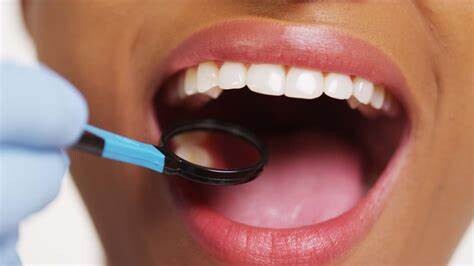
Monitor Sugar and Carbohydrate Intake
Why are sugars and carbohydrates harmful? Because when they combine with the plaque that’s already on our teeth, it creates acids that eat away at your enamel, resulting in cavities.
Because of this, it’s best to monitor sugar and carbohydrate intake by reading the nutritional contents of labels. Select foods that have low sugar levels whenever possible, and limit the number of carbs and starchy foods in your diet.
If carbs are a must, go for whole grains whenever possible. Eating whole grains will help keep your gums and teeth healthy while also providing you with a higher amount of fiber. These options include whole-grain cereals, bread, and more.

Whole grains or not, when you do eat or drink foods higher in sugar or carbohydrates, try to clean your mouth out within a half-hour or so if possible. Brushing your teeth is the best way to do this, but we know that’s not always an option. Alternatives include swigging some mouthwash, chewing sugarless gum, and…
Drink Lots of Water
While water doesn’t have specific nutritional value, it is absolutely the best thing you can drink to help prevent tooth decay and cavities. Why? Because unlike just about every other kind of drink, it does no harm.
That may sound like faint praise, but it really does matter. Water provides you with a way to wash out leftover food and harmful films that may be covering your teeth – including the always-dangerous acids – and it does this without leaving anything bad behind. No other drink can really say this.
Eat a Well-balanced Diet
It’s not enough just to minimize the harmful things you eat. You also need to eat larger amounts of nutritious foods – and more variety. Specifically, you should eat a varied mix from the five food groups: whole grains; fruits; vegetables; lean meats such as beef, fish, or chicken; and dairy products that are fat-free or low-fat.
Bring on the Calcium
Calcium in dairy foods is a great way to help prevent cavities. It also encourages the production of saliva.
Healthy, calcium-rich dairy options include cheese, milk, and yogurt. Beyond dairy products, there are other foods that contain calcium such as greens like broccoli, collard greens, spinach, and lentils, as well as salmon, kale, nuts, and beans.
Opt for High-Fiber
Consuming high-fiber foods will help keep the saliva flowing which aids in the prevention of cavities and tooth decay. This includes dates, figs, and raisins, apples, bananas, and oranges. Other high-fiber foods include peas, Brussel sprouts, and nuts.
Add Vitamins and Supplements to Your Diet
The sad truth is that most of us don’t get the recommended daily amounts of vitamins and minerals from our diets. Working to change what you eat will help this, but even then it’s not easy. Just try getting enough potassium without eating a dozen bananas a day!
Because of this, adding vitamin supplements to your routine can prove beneficial. Vitamins stimulate saliva production, which will help make your teeth much stronger.
Of course, altering your diet only goes so far. You still need to book time with your dentist for regular cleanings and check-ups. The difference is that – if all goes well – they’ll have a lot less work to do!
(12/18/2024)by South Florida Dental Care
More Information: N
Views: 602
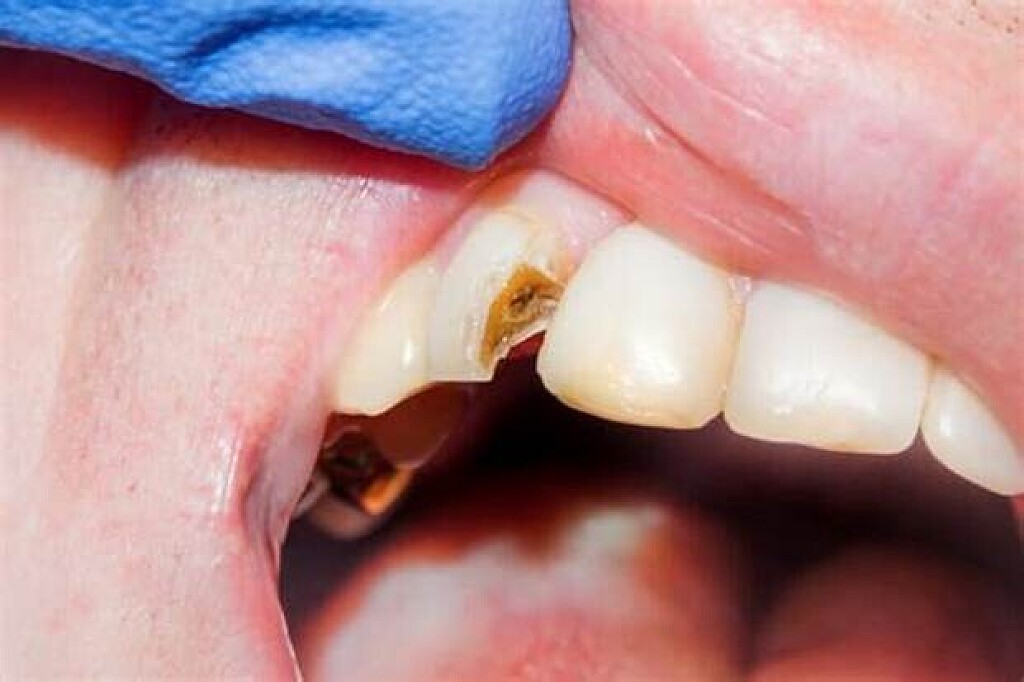
Can a Badly Decayed Tooth Be Saved?
Healthy teeth play a crucial role in both our physical and mental health. Furthermore, teeth also influence our appearance, affect our smile, and are essential for eating and speaking without discomfort.
Despite knowing how crucial teeth are for our overall appearance and health, unfortunately, many people fail to address tooth decay until it’s too late. It is essential to consult a dentist if one or more teeth are decaying. The sooner you realize it, the better it is for your oral health.
Often deep tooth decay leads to tooth extraction. However, there are other treatments also available to replace your damaged tooth. So, is it possible to save a badly decayed tooth?
How does tooth decay occur?
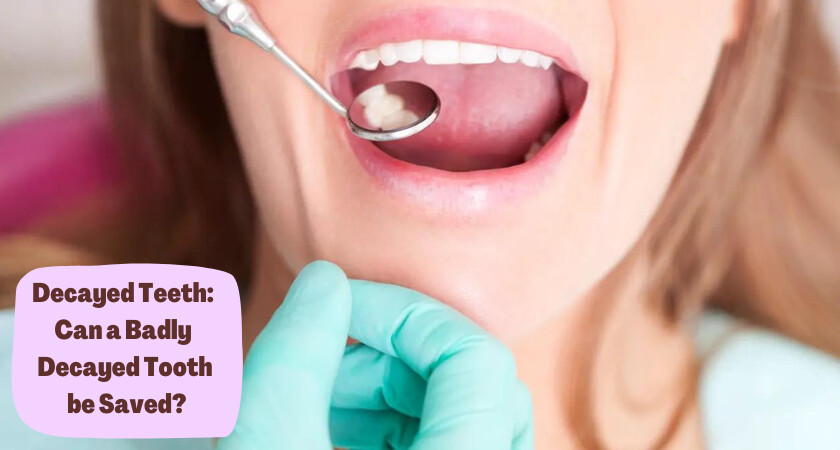
Decayed Tooth is damage to your teeth, potentially resulting in cavities, dental abscesses, or tooth loss in some cases. Bacteria present in dental plaque cause tooth decay.
The bacteria in plaque convert the sugars present in your food into acids. These acids will begin to damage your teeth if you allow plaque to build up over time. Therefore, good oral health is pivotal in preventing your teeth from decaying.
Tooth decay occurs in various stages. Let us explore these stages and find out how you can stop tooth decay from spreading.
What are the different stages of tooth decay?
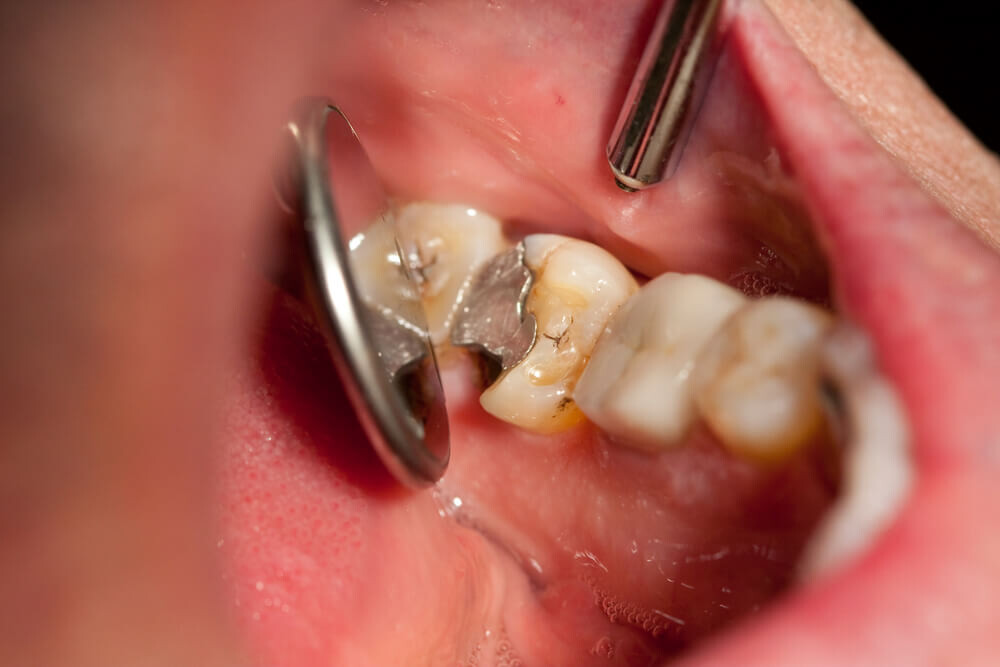
Dental plaque is a colourless, sticky film that covers the surface of your teeth, made up of bacteria, food particles and saliva. Plaque builds up gradually if your teeth are not regularly cleaned.
Tooth decay occurs in five different stages in general.
Stage 1: Initial demineralization (White spots)
The outer layer of your teeth is made of a tissue called enamel, mainly made up of minerals. The enamel loses these minerals when a tooth is exposed to acids produced by bacteria.
You may see a white spot on one of your teeth, indicating the initial stage of tooth decay.
Initial demineralization is reversed by treating the teeth with fluoride. Fluoride strengthens the enamel and makes it more resistant to the acids generated by plaque bacteria.
Stage 2: Enamel decay
Your enamel will break down further if you allow the tooth decay process to continue. The white spots on teeth will soon darken to a brownish colour. It can result in cavities as the enamel is weakened.
Dentists use fillings to treat cavities.
Stage 3: Dentin decay
Dentin is a tissue lying under the enamel. It is softer than enamel; therefore, tooth decay occurs faster on reaching dentin.
You may experience sensitivity when having hot or cold food or drinks once the dentin is affected by tooth decay.
Dentin decay is possible to treat with Fillings in the early stage, or the dentist may suggest placing crowns in more advanced cases.
Before placing the crowns, the decayed area is removed first, and if necessary, some healthy tooth tissue may also be removed to ensure that the crowns fit nicely into your mouth.
Stage 4: Pulp damage
The innermost layer of your teeth contains the nerves and blood vessels that keep the tooth healthy. The layer is known as the pulp.
When the pulp layer is damaged, it may swell, hurting you significantly. You will need a root canal treatment that removes damaged pulp, and the crown will be placed on the affected tooth.
Stage 5: Abscess
Bacteria can invade and cause infection if the tooth decay begins to advance into the pulp. Increased inflammation in the tooth can cause a pocket of pus to form at the bottom of your tooth, known as an abscess.
Tooth decay can cause severe pain that may even radiate into the jaw. If an abscess is formed in your tooth, your dentist will primarily perform a root canal treatment to seal the tooth after removing the infection. In severe cases, the affected tooth may also need to be removed.
Stage 3: Dentin decay
Dentin is a tissue lying under the enamel. It is softer than enamel; therefore, tooth decay occurs faster on reaching dentin.
You may experience sensitivity when having hot or cold food or drinks once the dentin is affected by tooth decay.
Dentin decay is possible to treat with Fillings in the early stage, or the dentist may suggest placing crowns in more advanced cases.
Before placing the crowns, the decayed area is removed first, and if necessary, some healthy tooth tissue may also be removed to ensure that the crowns fit nicely into your mouth.
Stage 4: Pulp damage
The innermost layer of your teeth contains the nerves and blood vessels that keep the tooth healthy. The layer is known as the pulp.
When the pulp layer is damaged, it may swell, hurting you significantly. You will need a root canal treatment that removes damaged pulp, and the crown will be placed on the affected tooth.
Stage 5: Abscess
Bacteria can invade and cause infection if the tooth decay begins to advance into the pulp. Increased inflammation in the tooth can cause a pocket of pus to form at the bottom of your tooth, known as an abscess.
Tooth decay can cause severe pain that may even radiate into the jaw. If an abscess is formed in your tooth, your dentist will primarily perform a root canal treatment to seal the tooth after removing the infection. In severe cases, the affected tooth may also need to be removed.
What you should do
If you experience pain or swelling, immediately visit your dentist and see what they say. If the dentist spots cavity or tooth decay, they will usually recommend you a filling as the best treatment option.
Sometimes tooth decay is unavoidable even after having great at-home oral hygiene; in such cases, dental checkups every six months can help identify and address decay at its initial stages.
(12/18/2024)
by Dr.Quadri.
More Information: https://drquadri.com/decayed-teeth-can-a-badly-decayed-tooth-be-saved/
Views: 577

